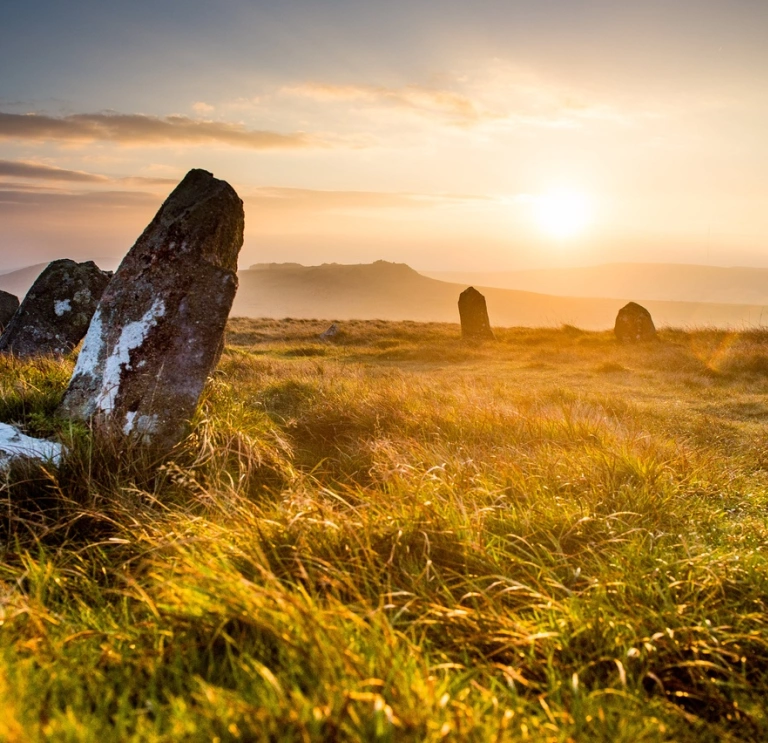March, Mis Mawrth, comes in like a lion and goes out like a lamb. On the 20th of the month each year the spring equinox marks the moment when day and night are an equal twelve hours each, and no matter where you are on the planet the sun rises due east and sets due west.
Wales is peppered with beautiful and historically significant places, perfect for watching the sun rise. Set your alarm early and take along a hot flask, and you will be rewarded with a special moment of calm. Welcome the spring, connect with the local heritage, and snap a perfect photo.
Castell Dinas Brân, Llangollen
Medieval arches and angry giants
On the northern outskirts of Llangollen is a pointy hill crowned with the ruins of a medieval castle. It’s clearly a summit that needs to be conquered – there’s proof that beneath the ruins are remains of a timber stronghold, and an iron age hillfort too.
The castle was in use for just twelve short years. In this time, according to legend, the princess Myfanwy Fychan lived here. The famous song ‘Myfanwy’, often sung by Welsh male voice choirs, was written about her.
Castell Dinas Brân is also mentioned in a 12th century story. A band of Norman knights dared to stay overnight in the haunted ruins, and defeated the tyrannical giant Gogmagog. He apparently left behind treasure, so keep an eye out.
The climb is steep but short, and the panoramic view from the top is well worth it. Enjoy the sunrise framed by the arches, then back down for a coffee in town and the comforting knowledge that spring is on the way.
Read more: Castles of Wales with the strangest stories

St Lythan’s burial chamber, Cardiff
Whirling stones and the return of the sun
This 6000-year-old burial chamber near Cardiff is older than Stonehenge and the pyramids. The stones were part of a Neolithic long barrow, aligned due east/west. During equinoxes the sun rises directly ahead of the entrance, and would have penetrated the length of the chamber. It is suggested that the barrow signifies a ceremonial womb.

St Lythan's enormous four-metre capstone is still balanced above three tall upright stones. This is unvarnished history – there are no facilities, and the site has never been excavated. Just park in a layby, trek the short way across the field and enjoy the quiet sunrise: just you, the stones, and whatever lies beneath.
There are other good times to visit the chamber. On Midsummer’s Eve the capstone apparently whirls around three times while the other stones go down to the river to bathe! And should you visit at Halloween, whisper a wish to the stones and it will be granted.
The Rocking Stone, Pontypridd
Megalithic and modern stone circles
Millennia ago, during the Ice Age, a colossal boulder was deposited on what became Coedpenmaen Common, by retreating glaciers. This megalithic remnant settled into the earth, its weight anchoring it to both soil and spirit.
It became known as the Rocking Stone, Y Maen Chwyf or Y Garreg Siglo in Welsh, and became a focal point for public gatherings. In 1814, stonemason Edward Williams, also known by his Bardic name - Iolo Morganwg - orchestrated a Gorsedd (a gathering of bards) at the Rocking Stone. They stood in a circle, their voices rising like incantations. The stone absorbed their creative energy, becoming a focal point for inspiration.

In 1849, bardic fervour led Evan Davies (Myfyr Morganwg) to encircle the Rocking Stone with smaller stones. This sacred ring became a stage for poetic recitations and Druidic services at the solstices and equinoxes.
Whispers persist that during rare celestial alignments, the ancient Rocking Stone tilts ever so slightly. Find out for yourselves - visit the Rocking Stone on the Pontypridd Circular Walk.
The Golden Road, Preseli Hills, Pembrokeshire
Jagged bluestones and magical pigs
The Golden Road is a seven-mile Neolithic route along the wild moorland of the Preseli ridge, between the jagged bluestone hilltops. It runs west to east, so an equinox walk would be truly golden. Head from Foel Eryr, the Place of the Eagle, into the path of the rising sun.
There’s a lot to contemplate while you walk, as the route passes many burial cairns of Bronze Age VIPs, the impressive long-inhabited Iron Age fort of Foel Drygarn, and the living museum fort of Castell Henllys. The area is steeped in Arthurian legend, and this path was stalked by the ‘wereboar’ Twrch Trwyth, the size of a battlehorse.


It may have been a trading route, for droving animals and carrying Irish gold to Wessex. It was perhaps also the route of the enormous bluestone slabs which became the inner circle of Stonehenge, 160 miles away.
Most excitingly of all, it was recently found that many bluestones ring like bells when hit with small hammer stones, suggesting a musical ritual, or a knees-up, 4000 years ago!




